More than half the world now owns a smartphone, and for one obvious reason: the amount of data and computing power, one that can be carried in our pockets, is unprecedented in world history. It is a testament to the mobile technology revolution. The past decade has produced better, faster, and prettier devices. But what makes the best smartphones of 2017 so different is that the price of access has skyrocketed.
Apple, with over 700 million buyers one of the most profitable companies in the world, surpassed even itself when it released two redesigned smartphone models earlier this month, one of which is valued at a whopping starting price of $999.
Many Wall Street analysts predict that the iPhone pricing strategy will be profitable, especially in the North American and European markets that offer upgrade programs and monthly payments. Paid in minimal monthly installments, the four-figure price tag of the new iPhone becomes relatively negligible. However, although $1000 for the 64-gigabyte model might cost only around $42 per month over two years if you finance your phone via the monthly payment program, it still amounts to $1000 for one smartphone.
So how do people really feel about shelling out $1000 on a smartphone? Is Apple, Inc, about to create a strong demand for iPhone X that could boost the company’s sales and earnings? As curious data scientists, we decided to find out by mining alternative data sources of online crowds who use smartphones in hopes of predicting whether or not the new iPhone is a justifiable expense.
Alternative data sources are non-traditional data sources, which when analyzed yield additional insights that can complement the information afforded by traditional financial data sources. By mining multiple sources of data together, you can learn something unique and even understand trends before they happen. In this case, we mined Twitter data, news articles and search queries data to learn the wisdom of crowds, a notion derived from Aristotle’s “doctrine of the wisdom of the multitude,” which refers to the idea that large groups collectively can shape businesses, societies and nations.
Our objective, therefore, was to connect multiple data points pertaining to online customers to build an early customer satisfaction index that could potentially predict iPhone sales over time.
First, we examined the competitive landscape dominated by four major contenders: iPhone X and 8, Samsung Galaxy Note 8, Nokia 8 and Google Pixel 2. To do so, we amassed a sizable number of over 200,000 tweets and around 2,200 news articles published from August 1st to August 31st. In the grand tug of war between mobile followings, we discovered that the iPhone X/8 was the most frequently mentioned smartphone, followed by the Samsung Note 8, which took the lead on August 23rd, its release date. Google Pixel 2 and Nokia 8 each received a comparatively low number of mentions, although the latter garnered significant positive reviews, indicating a likely comeback for its makers. The following graphs summarize our findings:
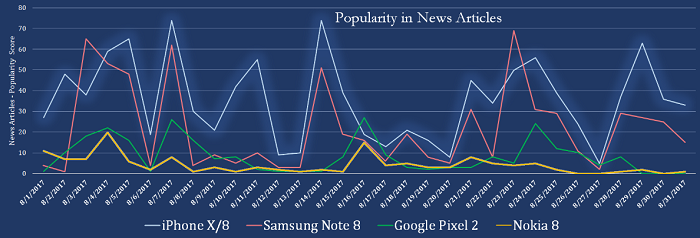
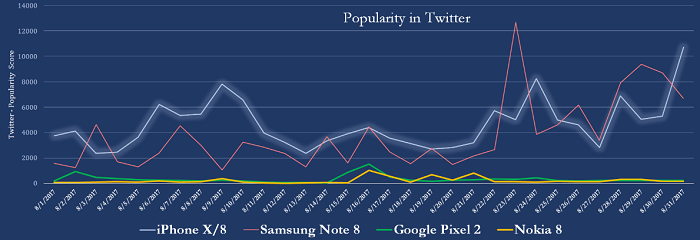
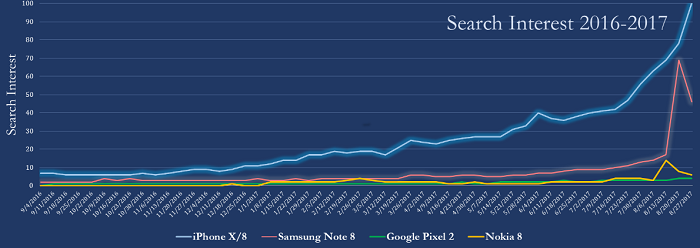
Next, we applied an ensemble of sentiment analysis algorithms to the Tweets and news articles to measure the emotional response of users to the respective products. Sentiment analysis, also known as opinion mining, is a technology that can computationally categorize opinions expressed in text in order to determine the writers’ emotions and attitudes toward a particular topic.
Generally, a large percentage of the data consisted of negative sentiments about all major smartphones, and the new iPhone is no exception. The iPhone releases received a noteworthy number of mentions, but upon closer inspection, natural language processing algorithms indicate that there were some concerns over price, the facial recognition feature and privacy, battery life and the delayed release date following months of speculation and leaks. To alleviate precisely these possible grievances, Apple released the iPhone 8 and iPhone 8 Plus prior to iPhone X. They may be simply a refinement rather than a revolution but they remain compelling options. We also believe that Apple released cheaper iPhones (iPhones 8 and 8 Plus) prior to the upcoming iPhone X to specifically target customers who are sensitive to paying $1000 for iPhone X or those who might have concerns about unlocking their phone using a facial-recognition technology.
Notably, some of the positive tweets for the new iPhone are attributable to the potential price drops of its predecessors (iPhones 6 and 7). Those who could not previously afford an iPhone 6 or 7 can now benefit from saving several hundred dollars and still own a stellar device.

Finally, we examined how the traction surrounding the new iPhone compares to that of its past predecessors iPhones by building a Google-based search index for Apple prior to the release date of each iPhone model.
Historical data suggest that the iPhone 6 prevailed against the iPhone 5, 6s and 7, not only in terms of pre-release traction but also in its post-release sales. The new iPhones X has been exceeding the iPhone 6 in terms of pre-release engagement, presumably indicating a bright future for the new iPhone X’s sales that could potentially match or outperform the sales of iPhone 6. Moreover, our analysis indicates a correlation between the number of search queries and iPhone sales. We also discovered that a large move on the search queries is followed with a large move on iPhone sales.
Here is what that looks like in graphs:
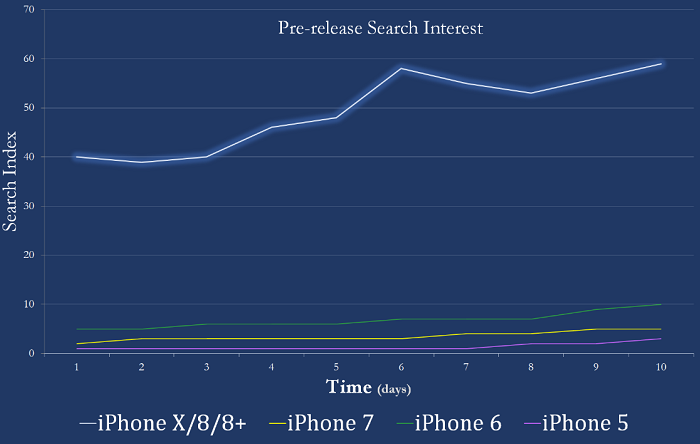
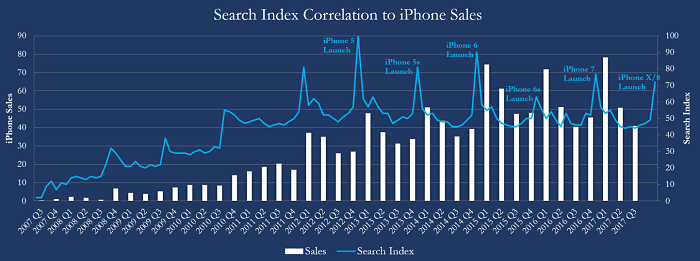
Comparing our results from the Apple search index, sentiment scores, and historical records, we perceive convergence: The iPhone X could be very successful if the price is not a deterrent, and it likely won’t be, given the recent release of the cheaper iPhones 8 and 8 Plus, and the cost-effective monthly payment model and upgrade program. A very large number of customers bought iPhones 6 and 6 Plus since 2014. Many of those owners will seek an upgrade this year. The search interest in iPhone X has been on the rise, which indicates that there is a large demand for the new iPhone. A “supercycle” for Apple could be easily on its way if Apple meets the demand on time.
About the Authors
 Anasse Bari holds a Ph.D. in Computer Science from George Washington University with a focus on data mining. Dr. Bari is currently a clinical assistant professor of computer science at New York University. He is teaching computer science and conducting research on developing an evidence-based decision support framework to better understand financial markets. He was the recipient of the World Bank Spot Award for his extraordinary efforts in service of the organization. Bari, a Fulbright scholar, is the co-author of the bestselling book Predictive Analytics for Dummies, published in 2016 by John Wiley & Sons, Inc.
Anasse Bari holds a Ph.D. in Computer Science from George Washington University with a focus on data mining. Dr. Bari is currently a clinical assistant professor of computer science at New York University. He is teaching computer science and conducting research on developing an evidence-based decision support framework to better understand financial markets. He was the recipient of the World Bank Spot Award for his extraordinary efforts in service of the organization. Bari, a Fulbright scholar, is the co-author of the bestselling book Predictive Analytics for Dummies, published in 2016 by John Wiley & Sons, Inc.
 Lihao Liu is a software engineer who has experience in software architecture and database design. Lihao has been conducting research using predictive analytics and natural language processing in the financial domain. He holds a Master’s degree in computer science from the Courant Institute of Mathematical Sciences of New York University.
Lihao Liu is a software engineer who has experience in software architecture and database design. Lihao has been conducting research using predictive analytics and natural language processing in the financial domain. He holds a Master’s degree in computer science from the Courant Institute of Mathematical Sciences of New York University.
Sign up for the free insideBIGDATA newsletter.




Speak Your Mind